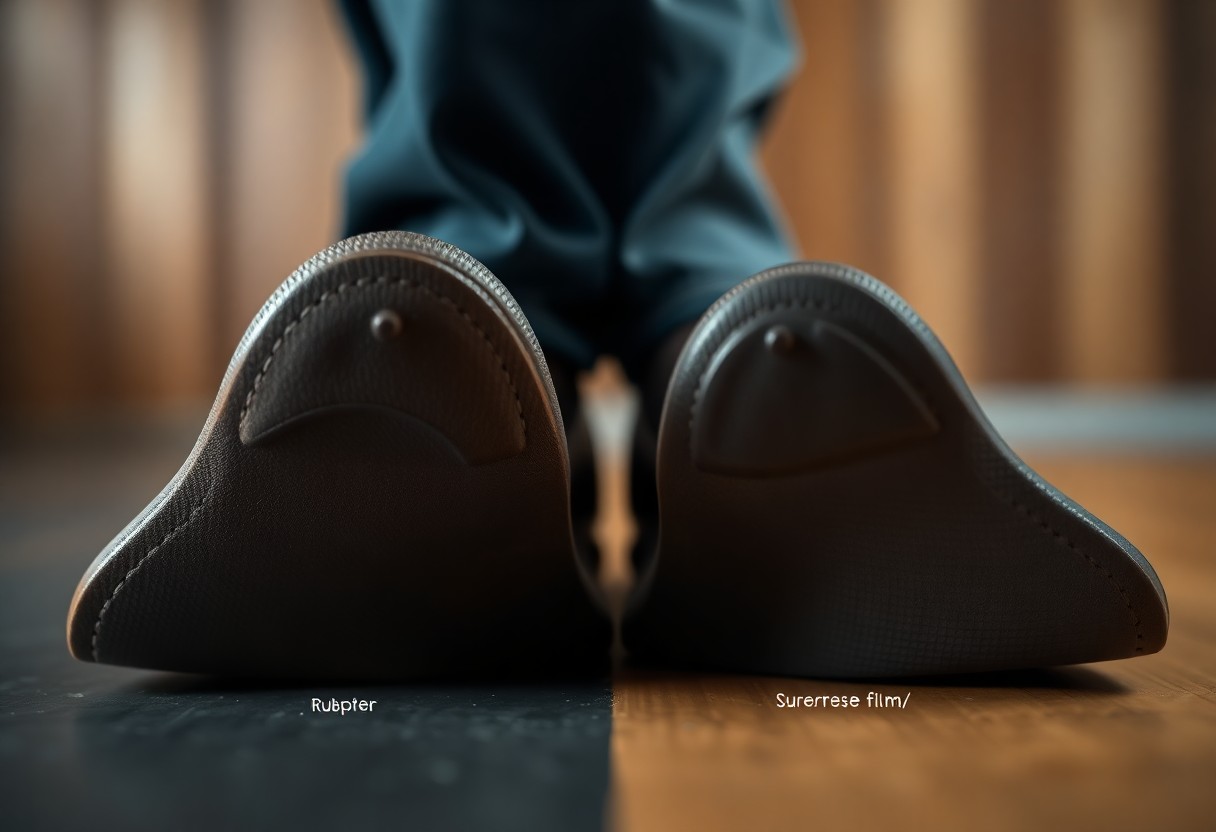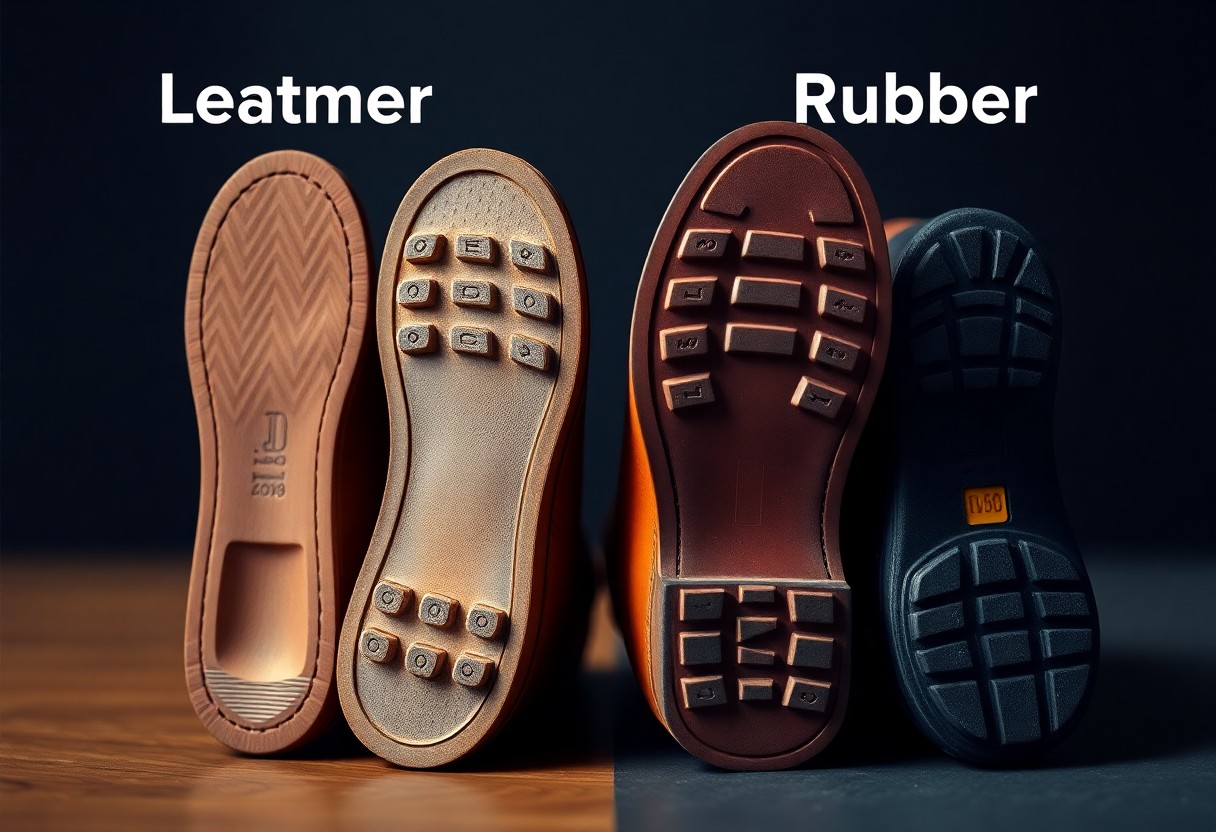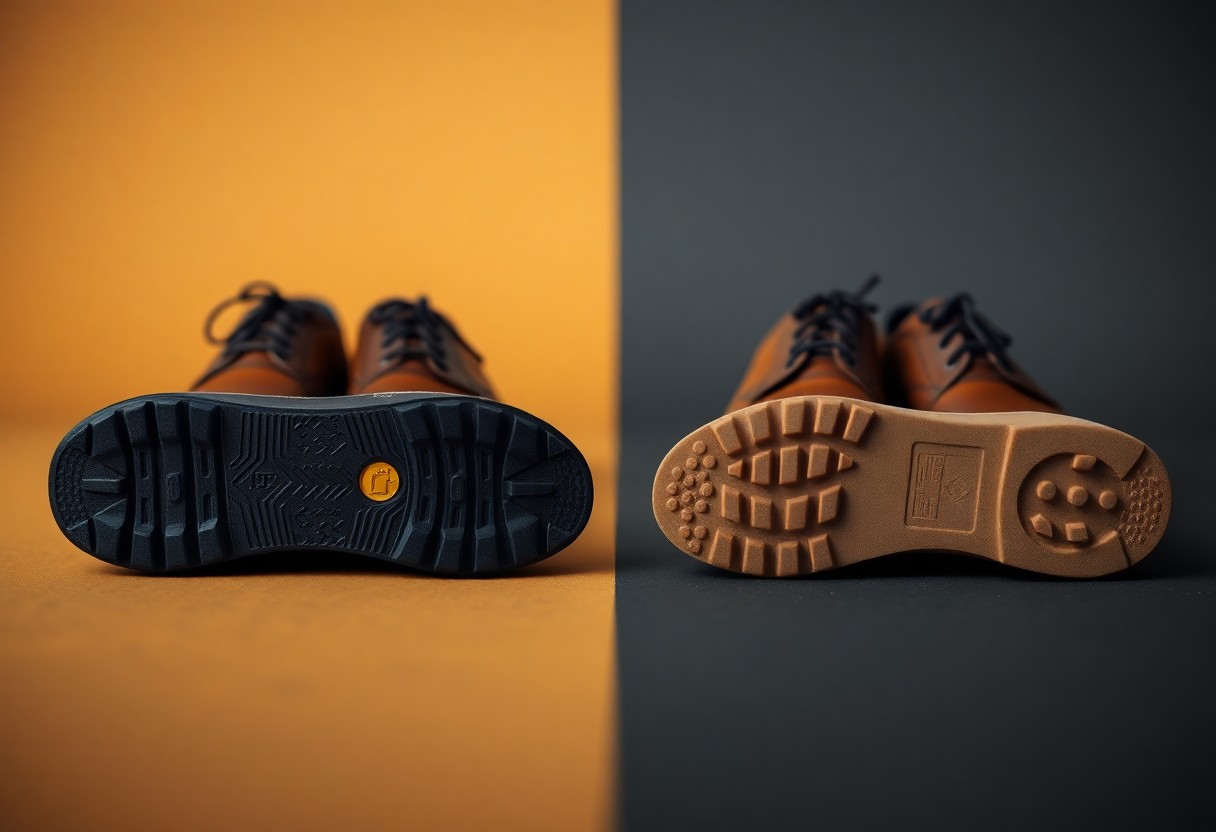When purchasing new footwear, buyers often face the decision between leather and rubber soles, a choice that can significantly impact both comfort and walking experience. Leather soles offer superb breathability and the ability to mold to the unique contours of your feet, providing a personalized fit that enhances comfort over time. On the other hand, rubber soles are celebrated for their excellent grip and water resistance. While leather soles are preferred for formal occasions and develop distinct character with age, rubber soles provide immediate comfort and superior traction, particularly in wet conditions. This detailed guide will assist you in understanding the fundamental differences between these materials, enabling you to choose the most suitable sole option tailored to your individual requirements.

Discovering the Distinctive Features of Footwear Sole Materials
Developing a comprehensive understanding of the various sole materials available empowers you to make knowledgeable footwear decisions. Each material has unique benefits and disadvantages that can significantly affect your daily comfort, shoe lifespan, and overall satisfaction. The choice between leather and rubber soles will influence not only your walking experience but also your foot health and the maintenance requirements of your footwear.
Uncovering the Advantages of Leather Soles
For centuries, leather has been regarded as the premium choice for high-quality footwear. Shoes featuring leather soles are crafted from natural materials that gradually conform to the shape of your feet, ensuring a tailored fit that enhances comfort over time. The material promotes airflow, allowing your feet to breathe and adjust to temperature changes. With proper care, leather soles can last between 3 to 5 years with regular use, making them a valuable investment.
Highlighting the Benefits of Rubber Soles
Renowned for their impressive water resistance and immediate flexibility, rubber soles are a popular choice. Shoes equipped with rubber soles provide outstanding grip on slippery surfaces and offer instantaneous shock absorption, ensuring comfort right from the first wear. This material maintains its shape and performance across various weather conditions, making rubber soles an ideal selection for daily use and active lifestyles.
Rubber soles promise consistent performance even in challenging environments. You can typically expect a durability range of 2 to 3 years from high-quality rubber soles, requiring minimal maintenance. While rubber provides dependable traction and stability, particularly in wet or slippery scenarios, it generally lacks the breathability offered by leather.
Examining Comfort Factors Associated with Sole Materials
Understanding how different sole materials affect your daily walking experience is crucial for making the right choice. The selection between leather and rubber soles can dramatically influence your foot health and overall comfort. The perfect sole material should correspond with your walking patterns, foot structure, and daily activities to guarantee a satisfying fit.
Comfort Features of Leather Soles
The comfort provided by leather soles stems from their unique ability to mold naturally to your feet and their inherent breathability. Your feet enjoy several benefits, including:
- Custom contouring that adapts to your foot shape
- Natural air circulation that aids in keeping your feet dry
- Cork layer cushioning that amplifies comfort
- Progressive softening with continued wear
By recognizing these features, you can make an informed decision that prioritizes long-lasting comfort and foot health.
Immediate Comfort Provided by Rubber Soles
Rubber soles excel in various weather conditions, delivering instant comfort and shock-absorbing capabilities. You will experience immediate flexibility with little to no break-in time, making rubber soles perfect for quick, on-the-go use.
The advanced technology behind rubber soles provides outstanding grip and water resistance. While rubber does not conform to your feet like leather, it consistently delivers excellent shock absorption and retains its shape, offering protection against hard impacts. This makes rubber soles suitable for extensive urban walking, enhancing your comfort in crowded environments.
Assessing the Longevity of Sole Materials
When deciding between leather and rubber soles, it’s vital to consider their differing wear patterns and total lifespan. Your walking habits and local weather conditions can greatly influence the durability of your soles. Both materials possess unique advantages regarding durability, but their effectiveness can vary significantly based on usage and maintenance over time.
Exceptional Longevity of Leather Soles
With appropriate care and maintenance, leather soles can offer remarkable durability. When shielded from excessive moisture and equipped with toe taps, leather-soled shoes can last from 3 to 5 years with regular use. The quality of leather can be enhanced through multiple layers; for example, a triple leather sole can outperform many other options. However, it is essential to keep them dry and well-maintained to ensure their longevity.
Resilience of Rubber Soles
Rubber soles are well-known for their superior resistance to water and daily wear. Your rubber-soled shoes can endure demanding conditions and typically last between 2 to 4 years of regular use. These soles excel on wet surfaces and require significantly less maintenance compared to leather alternatives.
Nonetheless, it’s important to recognize that the durability of rubber soles depends on the quality and thickness of the rubber compound used. High-quality rubber compounds can last up to 8 years with proper care, while inferior versions may wear out within a few months. Your individual walking style and usage frequency will ultimately determine the actual lifespan of rubber soles.
Performance Assessment in Various Weather Conditions
To make an educated choice about your footwear, understanding how different soles perform in various weather conditions is essential. Your decision between leather and rubber soles can significantly affect your comfort and safety in diverse weather situations. Each material presents unique advantages and limitations that influence their effectiveness in wet, dry, or icy conditions.
Leather Soles in Varied Weather Conditions
Contrary to popular belief, leather soles may not be the best option for wet conditions. Water can harm leather soles, rendering them slippery. Leather performs best in dry weather, where it offers excellent breathability. In wet conditions, these soles can absorb up to 80% of their weight in water, leading to accelerated wear and potential damage to your footwear.
Rubber Soles in Diverse Elements
When comparing the two options, rubber soles provide superior grip and water resistance. You can confidently wear rubber-soled shoes in rain, snow, and on slippery surfaces, enjoying enhanced traction. These soles maintain their properties in temperatures ranging from -10°C to 40°C, making them more versatile for year-round use.
A significant advantage of rubber soles is their exceptional water resistance and durability in harsh conditions. They retain their shape and grip even after prolonged exposure to moisture. Their non-slip characteristics substantially enhance safety on wet surfaces, decreasing your risk of accidents by up to 50% compared to leather soles.

Choosing Stylish Footwear Options
When it comes to style, not all sole materials are created equal. Your choice of sole can significantly impact the overall appearance of your shoes and their suitability for various occasions. While leather soles radiate a refined and sophisticated aesthetic, rubber soles offer greater versatility for everyday wear. Your selection should align with your lifestyle and the intended use of your footwear.
Timeless Elegance of Leather Soles
For formal occasions, leather soles remain the preferred choice. They are prominently featured in high-end dress shoes and formal footwear. The sleek profile and natural patina that develops over time enhance their visual appeal. Your leather-soled shoes will present a clean edge and maintain an elegant silhouette that epitomizes classic footwear design.
Contemporary Flexibility with Rubber Soles
Today, approximately 70% of modern shoes are designed with rubber soles. Your daily activities often require shoes that can adapt to various surfaces and changing weather conditions. Rubber soles provide improved grip and weather resistance, making them ideal for business casual environments and everyday wear.
Additionally, it’s noteworthy that modern hybrid options combine both materials, offering the best of both worlds. These innovative combinations provide the elegance of leather along with the practicality of rubber. You can find dress shoes featuring thin rubber inserts or entirely rubber soles designed to mimic leather, offering a balanced solution for your footwear collection.

Analyzing the Financial Aspects of Sole Materials
Despite the initial cost differences, your choice between leather and rubber soles affects both short-term expenses and long-term value. Leather soles may require more maintenance and occasional resoling, but they can last 15 to 20 years with proper care. Rubber soles may provide better immediate value, yet they typically require complete replacement once they are worn out.
Understanding the Initial Cost of Investment
Generally, leather-soled shoes are priced 20 to 30% higher than their rubber-soled counterparts. Investing in leather soles reflects the cost of high-quality materials and the skilled craftsmanship involved in their production. This higher upfront expense often signifies superior construction methods, such as Goodyear welting, which ensures durability and longevity.
Assessing the Long-term Value of Sole Materials
Initially, rubber soles may seem more cost-effective, but leather-soled shoes can provide better value over time. With proper maintenance and resoling, leather-soled shoes can endure for decades, while rubber soles frequently necessitate complete replacement once they wear out.
While leather soles require routine maintenance and resoling every 2 to 3 years, the costs of these services are generally lower than purchasing new shoes. Your investment in leather soles pays dividends due to their capacity to be repaired and restored, a feature that most rubber soles lack once damaged.
Making the Right Choice for Your Footwear Preferences
Your decision between leather and rubber soles ultimately depends on your unique needs and lifestyle. Leather soles provide superior moldability and elegance, making them ideal if you seek shoes that adapt to your feet while exuding a classic appearance. Conversely, rubber soles offer immediate comfort and excellent water resistance, making them perfect for individuals who frequently walk in wet conditions. Your walking habits, local climate, and personal comfort preferences will all play an essential role in guiding your choice. Both types of soles have their place in a well-rounded footwear collection, allowing you to select based on the primary purpose for each pair.
Your Questions Answered: Common Inquiries about Sole Materials
Q: What are the comfort differences between leather and rubber soles?
A: Leather soles gradually conform to your feet, creating a customized fit that enhances comfort over time. They perform best when paired with cork filling and adequate arch support. In contrast, rubber soles provide immediate flexibility and superior shock absorption but do not mold to your foot shape. While leather offers better all-day comfort once broken in, rubber tends to feel comfortable initially but may lead to foot fatigue during prolonged wear.
Q: How do leather and rubber soles compare in terms of durability and weather resistance?
A: Double or triple leather soles with toe taps can last for many years with proper care. However, single leather soles wear out more quickly and are susceptible to water absorption. Rubber soles excel in water resistance and handle rough surfaces effectively. They require less maintenance and perform better in wet conditions. Ultimately, the choice depends on your walking environment and usage frequency.
Q: Which type of sole should I choose based on my specific needs?
A: Opt for leather soles for formal shoes and office wear, particularly if your activities occur mainly indoors. They offer better breathability and elegance. Alternatively, choose rubber soles for daily commuting, frequent outdoor walking, or rainy climates. Consider your walking surface—leather performs well on carpet and smooth floors, while rubber excels on rough pavements and wet surfaces.
The Article Leather soles vs rubber soles key differences benefits and how to choose the right one appeared first on My Shoes Finder
The Article Leather Soles vs Rubber Soles: Key Differences and Benefits Was Found On https://limitsofstrategy.com